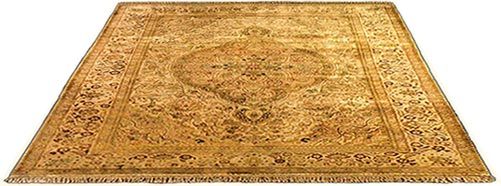
About Handmade Oriental Area
Rugs
AN INTRODUCTION FOR THE CONSUMER
Historical Perspective
Introducing you to the exciting world of handmade Oriental area rugs - a world of timeless beauty and cultural mystique that has remained virtually unchanged for centuries. The information offered here provides the reader with both a general understanding of the origin and the creation of an Oriental rug, as well as some of the advantages of including these handcrafted rugs in your decorating plans for your home, office, or wherever a floor covering is needed.
While a variety of weavings are mentioned in ancient writings, the origin of handwoven Oriental rugs is uncertain. The earliest surviving piece, known as the Pazyryk carpet, dates back to about 400-500 B.C. Discovered in a burial site excavated in southern Siberia in 1947-49, it is now part of the Hermitage Museum Collection in Leningrad.
Dramatic changes have occurred in today's handmade Oriental carpet industry. Although weaving techniques and traditions have remained virtually unchanged, the weavers have found it more advantageous to adapt designs and colors to better satisfy Western decorative tastes. Moreover, throughout the 1980s, the production of Persian-design carpets in other countries, particularly India, China, Pakistan, and Rumania has increased significantly, offering consumers an ever-wider range of color and design choices available in a full range of prices.
Defining Terms
What exactly is an Oriental rug? As defined by the Oriental Rug Importers Association, Inc., an Oriental rug is:
- " . . . handmade of natural fibers (most commonly wool or silk), with a pile woven on a warp and weft, with individual character and design made in the Near East, Middle East, Far East, or the Balkans."
An Oriental rug is handwoven and varies in quality. Quality is generally determined by the wool, intricacy of design, and knot density. Wool quality is defined by the length of its fibers, springiness, and luster. Today, the wool used in handknotted Oriental rugs either originates exclusively from the country of origin or is a blend of indigenous and imported wool. Intricacy of design refers to the degree of detail a design possesses as well as to the number of different colors needed to execute the pattern. The more complex the design, the more experienced the craftsman must be to weave the pattern. Finally, knot density and fineness of weave are synonymous. The more knots tied per square inch, the finer the detail in the design and the more labor-intensive the production.
While machine-made carpets are manufactured to machine-like tolerances, handmade rugs reflect the human element the individual's own interpretation of color and design which is the essence of their beauty and singularity. In the following pages, you are invited to discover the fascinating, exotic world of Oriental rugs and to see for yourself how their use enriches your decorating plans.
The Principles of Rug Making
Although some of the special techniques involved in weaving an Oriental rug may vary from country to country and even from one region to another, the principles of rug-making from dyeing the yarn to shearing the finished piece are virtually the same throughout the world and have changed very little over the centuries. Still, a basic understanding of an Oriental rug's construction will be invaluable to you when selecting an Oriental rug.
By and large, most Oriental rugs feature a wool pile, mainly derived from sheep, whose quality depends on factors such as the animal's breed and diet, local climate, and shearing season. After shearing, the wool is washed, carded (i.e., a teasing process that straightens the fibers), and then hand - or machine - spun into yarn. Next, the yarn is dyed in an attractive range of colors and then dried slowly in the sun.
 |
 | |
| After the wool has been spun into yarn it is dyed. | After being dyed, the yarn is dried slowly in the sun. |
A detailed illustration of the carpet design, most commonly called a cartoon, guides the weavers throughout the entire rug-making process. The design is rendered on graph paper to scale.
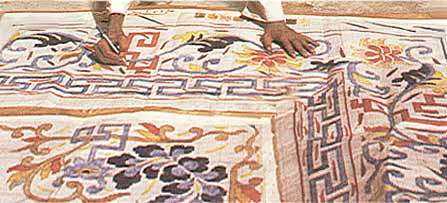 |
| A detailed drawing of the carpet's design, which has been rendered to scale
on graph paper, is the weaver's guide throughout the entire weaving process. |
Through the ages, looms have remained relatively unchanged. While the most primitive is the nomadic or horizontal loom, the type most generally used today consists of two vertical beams of either wood or metal and two similarly made horizontal beams. The distance between the vertical beams determines the rug's width. Warp threads, usually cotton, are strung between the horizontal beams at a consistent tension. The thickness of the warp threads and the closeness at which they are strung are two of the elements that will determine the fineness of the weave (i.e., knot density) of the carpet that is ultimately woven.
Turkish/ Symmetrical Knot |
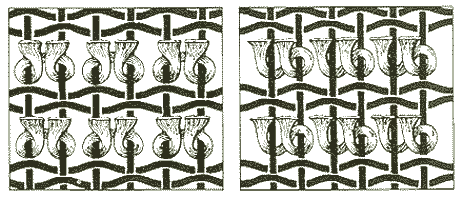 |
Persian/ Asymmetrical Knot |
There are two types of knots used in rug-weaving: the Turkish knot (also called Ghiordes
or symmetrical knot) and the Persian knot (also known as Senneh or asymmetrical knot).
With the average weaver able to tie 10,000 to 14,000 Turkish or Persian knots a day,
several weavers working together can only complete one or two inches of the carpet a
day.
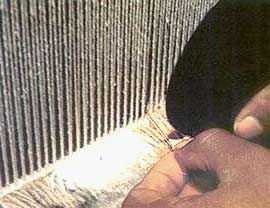 |
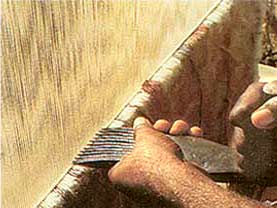 | |
| The weaver ties a knot around two adjacent warps, slides it down to the base of the weft and cuts the yarn with a knife. | This procedure of tying and cutting creates the pile of the rug. |
Before the actual knotting of the pile begins, the rug is secured at the bottom of the loom by a short kilim, a flat pileless fabric, which is woven by passing several rows of horizontal cotton threads, or wefts, through alternate warp threads. After rolling the different-colored yarns to be used into balls, the weaver, reading the design from the cartoon begins weaving the rug. With the appropriate color yarn, the weaver ties a knot around two adjacent warps, slides the knot down to the base of the weft, and then cuts the yarn with a knife, thereby producing the pile. After each row of knots is completed, one or more weft threads are inserted to secure the knots and are beaten down tightly with a comb. At this stage, the pile ends are often cut level with a pair of shears. The alternation of wefts with rows of tied knots is repeated until the carpet is finished. Before removing the rug from the loom, another kilim is woven at the top. The fringe is formed by the cutting of the warps at both ends of the rug.
After the rug has been cut off the loom, the final finishing steps take place. First, the
selvedge edges (i.e., side edges of the rug formed by the continuous weft) are bound
or overcast with yarn to reinforce the side edges of the rug. Next, the warp
ends, which secured the rug to the loom, are knotted or braided to form the rug's
fringe. The rug is then washed either by hand or by machine to eliminate dust
and dirt that accumulated during weaving. In addition to cleaning the rug, the
type of wash given the rug can also impart an exquisite sheen and luster to the
wool as well as soften or antique the rug's colors.
 |
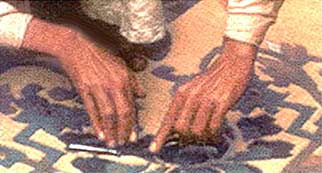 | |
| After the side edges of the rug are overcast and the fringe has been knotted the rug is washed. | On certain carpets motifs are accented by carving or incising. |
Once the rug is washed and dried, a carpet cutter shears the tops of the knots to create a uniform pile height. In addition to the surface shearing certain carpets feature carved or incised designs which highlight various motifs. Today, this type of accenting is often done to Chinese, Indian, and Turkish carpets. The Oriental rug is now completed and ready for shipment.
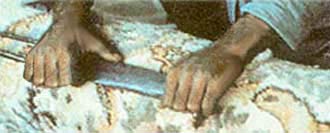
Once
the weaving has been completed the rug is cut from the
loom and the surface is sheared to create a
uniform pile height.
THE ILLUSTRATED ORIENTAL RUG
IRAN (Persia)
Known as the original home of the Oriental carpet, Iran (Persia) the oldest and once the most powerful empire in the Middle East, stood at the crossroads of Eastern and Western civilizations. Under the Safavid dynasty (1502-1736), Iran attained its artistic height, and court weaving, together with the art of calligraphy, miniature painting, and tilework, flourished to exceptional heights. This brilliant era witnessed the development of highly qualified carpet factories in cities including Kerman, Isfahan, Kashan, Tabriz, and Herat (now a part of Afghanistan). Iran is the genesis of most motifs, patterns, and traditional colorations produced in rugs throughout the world today. Over the centuries, Persian carpets have become treasured heirlooms passed on from one generation to the next.
Persian carpet exports began in the 16th century. Starting in the 1850s, American, English, and German firms established new factories in Meshed, Tabriz, Kerman, and Sultanabad (now Arak), thereby ensuring the art form's continued development. Under Shah Reza Pahlavi, royal factories were established to utilize only the finest materials and methods of manufacture.
Oriental rugs have always been and are still an intrinsic part of Iranian culture and its people's daily lives. Indeed, Oriental rugs are in many cases their most valued possession and are an integral part of their home furnishings. Thus, it is not surprising that current production levels throughout Iran equal if not surpass those reached prior to the Islamic Revolution of 1979. In fact, rugs are now even produced in areas where weaving was heretofore not practiced. Furthermore, Persian carpets continue to boast very high quality standards and command a very brisk interest in domestic and international markets. While large city workshops were an important factor in the past, much of today's production is fashioned along cottage industry lines in smaller villages and towns.
Persian carpets are traditionally known for their tremendous variety in design, color, size, and weave, and for the uniqueness of each and every rug produced. Rugs are generally named after the village, town, or district where they are woven or collected, or by the weaving tribe in the case of nomadic pieces. Each rug's particular pattern, palette, and weave are uniquely linked with the indigenous culture, and weaving techniques are specific to an identifiable geographic area or nomadic tribe. Such is the case, for instance, of the richly colored Bakhtiari rugs frequently characterized by ellipse-shaped medallions with floral patternswoven by the Bakhtiari nomads and villagers of southern Iran.
Generally smaller in size, Persian nomadic, village, and flat-woven rugs (e.g., kilims) are broadly characterized by traditional angular designs and bold as well as somber colors. Typical is the south Persian Qashqai, often finely woven and featuring a diamond-shaped medallion on a detailed background of geometric or stylized flowers. Predominant colors include reddish browns and blues. Other nomadic and village types include the Bakhtiari, Ramadan, Shiraz, Kurd, and Karaja.
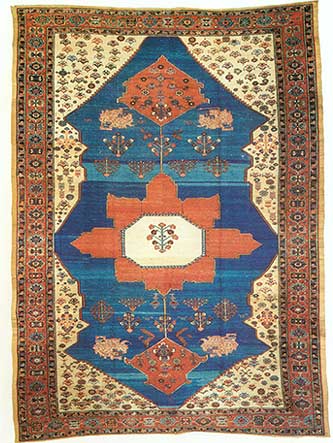 | IRAN BAKSHAISH |
Meanwhile, the more sophisticated carpets originating from the historic cities of Tabriz, Kashan, Kerman, Nain, and Qum feature finely woven floral patterns and complex curvilinear motifs. More elaborate pieces are often pictorial in design and depict hunting scenes, men in combat, landscapes, and historic folklore figures.
Persian carpets offer a full gamut of colorations from the pastel shades of champagne, rose, and green, typical of a Kerman for instance, to the striking reds and blues of a Heriz. This highly popular pattern is characterized by a bold and angular medallion and corner design. Just as with design, Persian color ways are a continued source of inspiration for other rug-producing countries throughout the world.
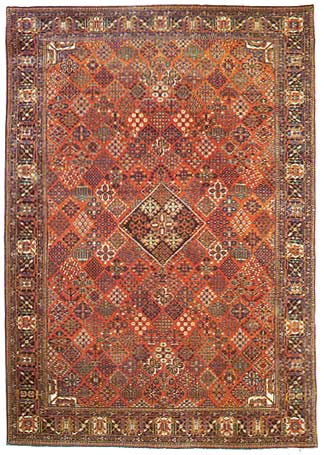 | IRAN KHOSROVABAD |
The popularity of the Persian carpet, both antique and new, continues unabated. Indeed, Persian rugs shall forever be prized for their unique, individual quality. Each carpet is the product of a centuries-old cultural heritage particular to its originating village, district, or tribe. This splendid weaving tradition continues to be the chief source of inspiration for other countries of origin, including India, Pakistan, China, and Rumania.
INDIA
Carpet weaving was introduced to India during the 16th century following the Mogul conquest of Akbar the Great. Influenced by Persian culture, this Moslem dynasty established carpet factories which produced Persian-inspired weavings as well as classic Mogul carpets featuring realistic floral and pictorial renditions. For centuries, India created among the most exquisite carpets in history, mainly in Jaipur, Kashmir, Agra, and Benares. Today, many of them are guarded museum masterpieces.
With the decline of the Mogul empire and the corresponding rise of the British empire during the 19th century, the international carpet trade developed an increasing interest in India. The years succeeding World War I witnessed a significant growth in exports to the United States, initially of coarser-quality rugs featuring the French Aubusson pattern (a formal floral design) and Chinese-inspired motifs. Beginning in the 1970s the Indian rug industry, responding to an international demand for Persian-design rugs, returned to its historic Persian weaving tradition by developing and producing increasingly finer qualities of rugs. Today, the Indian weaver not only creates works which rival their Persian counterparts but which also reveal a creative ingenuity of their own.
At present, India is one of the primary sources for both pile and flat-woven rugs available in an impressive range of qualities, designs, colorations, and sizes. Indeed, Indian weavers have demonstrated a remarkable ability to adapt to ever-changing Western decorative tastes while recreating Persian rug designs at increasingly higher quality standards. As in the past, Indian weaving production is currently organized on a cottage industry basis, and the vast majority of pile rugs and flat weaves are crafted in villages throughout the Mirzapur/Bhadohi region while smaller centers are located in Jaipur, Gwalior, Kashmir, Agra, and Amritsar.
Aubusson-patterned rugs are now a minor factor in the export market, as Persian-design carpets constitute the predominant category of Indian pile rugs woven today. Thanks to the weavers' expert understanding and execution of design, coloration, and knot density, these rugs are often considered to best approximate the look, texture, and feel of their Iranian-made counterparts.
Kashan, Tabriz, Kerman, Sarouk, and Bijar are among the many popular Persian patterns that have inspired faithful recreations and innovative adaptations. The Indian weaver has mastered the rendition of these patterns in traditional Persian-style hues (e.g., dark reds and blues) and in contemporary colorations, including jewel tones and pastels, attuned to the very latest in home furnishings fashion trends. Moreover, their rugs are produced in an impressive range of qualities averaging from approximately 85 to 150 knots per square inch. Some Indian weavers' dexterity is such that they are even able to produce carpets with over 300 knots per square inch. The woolen yarns used are generally blends of Indian and imported New Zealand wool which together provide the carpet with a naturally lustrous appearance. Additionally, a small number of all-silk carpets featuring about 400 knots per square inch continue to be produced in Kashmir.
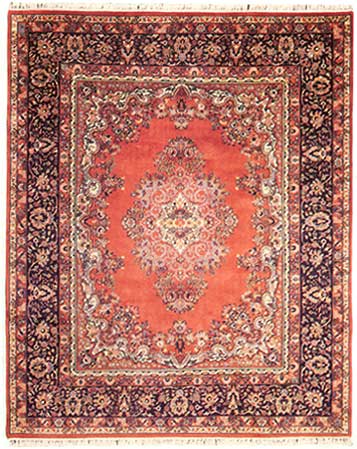 |
INDIA SAROUK |
The expertise of India's weavers extends beyond that of producing pile carpets. Indeed, the country is equally renowned for its production of flat weaves, notably dhurries and chainstitch rugs whose techniques are indigenous to its culture and date back possibly several thousands of years. These handcrafted flat weaves blend in with a variety of contemporary and traditional settings while offering an excellent and affordable purchasing opportunity that may be particularly appealing to the first-time buyer.
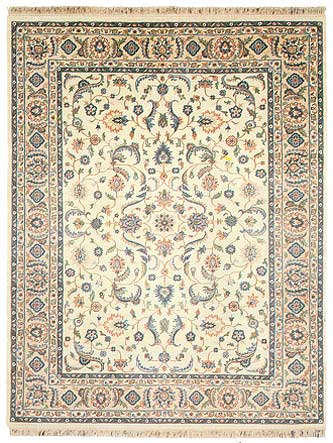 |
INDIA KASHAN |
Most popular in the last decade have been wool dhurries, now mainly characterized by floral designs in an array of fashionable colorations including pastels and more vibrant hues. Also available, although in lesser quantity, are cotton dhurries displaying bold geometric patterns. Chainstitch or crewel-embroidered rugs chiefly produced in and traditionally indigenous to Kashmir have recently experienced a tremendous resurgence in popularity thanks to their exquisitely detailed floral patterns, often European-inspired, executed in a full range of contemporary colorations.
India is a world leader in Oriental rug exports thanks to its tremendous production capacity and to its weavers' dexterity, versatility, and willingness to constantly experiment with color and design combinations in an attempt to be responsive to American consumer demand. India offers a complete range of pile and flat-woven rugs in a wide range of qualities, styles, colors, and sizes. These handcrafted floor coverings are suitable for a broad spectrum of decorative specifications in residential and commercial settings alike.
CHINA
Chinese carpets were first woven centuries ago by nomadic tribes in the Sinkiang and Ninghsia regions of western China where they were used for both decorative and functional purposes. In the early to mid-19th century, this simple craft began to flourish on a much larger scale at the Imperial Court of Beijing. Particularly instrumental in developing the art was the patronage of Ch'ien Lung, Chia Ch'ing, and Tao Kuang, three rulers of the Ch'ing Dynasty (1644-1912).
During the mid-to-late 19th century, China's entire carpet production was destined for local consumption, being sold commercially to the native noble and upper classes. Western awareness of Chinese weavings increased significantly during the Boxer Rebellion of 1900 when many palaces and residences were looted and the spoils of war were sent abroad. Chinese carpets first won official recognition at the 1903 Saint Louis International Exhibition where an entry was awarded first prize. With Western interest now kindled, substantial efforts were made to transform a cottage handicraft into a major industry in the Beijing/Tianjin area of northeastern China. In the 1920s, so-called Peking- and Tiensin-style rugs were produced according to American importers' specifications and were "all the rage" in the United States.
Following President Richard Nixon's memorable trips to China in 1971 and 1972, which resulted in the reestablishment of trade between the United States and China, Chinese carpets reemerged in the United States in 1973. They have since become a major force in the home furnishings market due to their tremendous versatility in type, style, and color, and executed with high quality control standards. Equally important has been the Chinese weavers' expertise and willingness to adapt designs and colorations to American decorative trends.
Most carpets are still woven in the northeastern provinces of China with the balance originating from the western and southern regions. Weaving is performed in factories scattered in cities and throughout the countryside. Rug production is essentially made up of autonomous provincial enterprises or cooperatives, each competing for a share of the market. The rugs are warehoused for export in the principal cities or ports of the producing provinces. Notable among the producing cities are Beijing, Tianjin, Qingdao, Shanghai, Dalian, Nanjing, Hangzhou, and Baoding.
The factories have from a few to several hundred looms, and the manufacturing process is closely supervised for quality control. While many of the looms are still built of wood, most new ones are built of steel. As they are so well built and stout, whether of wood or steel, crooked pieces are seldom produced. The carpets are woven of excellent quality indigenous wool featuring durable and resilient yarn or with a blend of native and imported wool.
Today's consumer has a wealth of patterns and colors to choose from both in pile and flat-woven rugs. The most popular design categories for pile rugs are Peking, floral, esthetic, and Sino-Persian. Peking rugs, stylistically the most indigenous to Chinese culture, generally feature a central medallion on an open or covered field of traditional and often stylized motifs and symbols, such as animals, flowers, clouds, and vases, framed by a simple, wide border. Equally in demand are floral rugs often characterized by an all-over pattern or by asymmetrically placed floral sprays. The popular Art Deco style floral carpets, based on the "Tientsin-style" rugs of the 1920s, generally feature an asymmetrical floral pattern sometimes with objects such as birds and pagodas, and wide solid-colored borders. Esthetic rugs inspired by the floral patterns of French Savonnerie and Aubusson carpets are generally characterized by a large central medallion and an open field with surrounding designs.
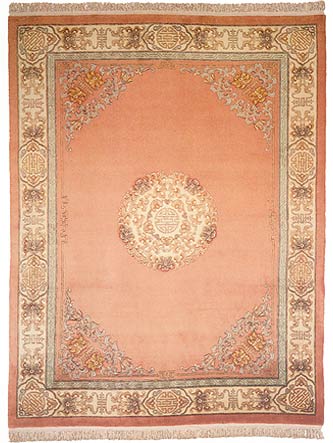 |
CHINA PEKING |
Peking, floral, and esthetic rugs' colorations are keyed to the very latest American decorative trends and range from pastels to the more vibrant jewel tones. These three rugs styles usually carved or incised to produce depth and shading are woven in qualities ranging from 70 to 120 lines and averaging 90 lines. This line count system is unique to China, and a 90-line rug, for instance, means that it has 90 knots in one linear foot both across the width and length of the rug and contains approximately 56 knots per square inch (90 knots times 90 knots divided by 144 inches per square foot equals 56 knots per square inch).
Undoubtedly, the most talked about category of Chinese carpets woven today is the Sino-Persian. These carpets rival their Persian-design counterparts originating in Iran, India, Rumania, and Pakistan. They are produced in qualities ranging from 120 to 300 lines, with most pieces averaging 200 lines (approximately 278 knots per square inch). Sino-Persian rugs are based on Iran's most celebrated designs, namely Kashan, Lavar Kerman, Sarouk, Tabriz, and Isfahan, and are executed in a broad array of both traditional Persian (e.g., dark reds and blues) and contemporary hues. After receiving hundreds of Persian designs from importers around the world, Chinese designers have now developed the ability to "rework" their vast repertoire of design elements into an infinite number of new designs rivaling Iran itself.
A smaller but nonetheless important segment of Chinese pile rug types includes contemporary-design pieces displaying a broad spectrum of free-form patterns and antique-style rugs that are attractive recreations of vintage Peking-style rugs often woven with vegetable-dyed wool. Also available are limited quantities of silk carpets, generally in smaller sizes, containing up to 625 knots per square inch.
Virtually unique to China is the production of wool pile rugs in odd shapes. Indeed, rounds, ovals, squares, and hexagons are available in a broad range of styles and colors. They are particularly well suited in defining a room's particular angle.
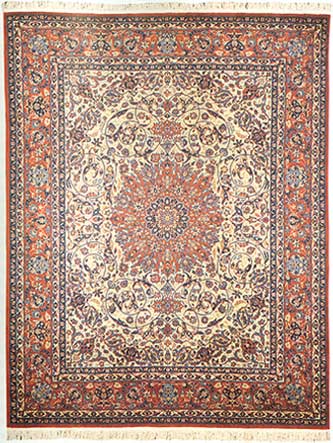 |
CHINA ISFAHAN |
In the last decade Chinese flat weaves, namely kilims and needlepoints, have made tremendous inroads into the marketplace. Chinese kilims offer an excellent variety of floral and geometric patterns in traditional and fashion-oriented colors and in a wide range of sizes including standard room sizes which are often difficult to find in other types of flat weaves. Needlepoint rugs have recently been reintroduced to the American market and are enjoying the same success they had had during the 1920s and 1930s. Hand-embroidered in wool, these floor coverings exquisitely recreate the look of 18th and 19th century English and French needlepoints in a vast spectrum of colors.
Noteworthy as well are tufted carpets (also referred to as full-cuts, gun-tufted, or latex-backed carpets) which haven been produced in China for several decades. Because these carpets are not woven on a warp and weft foundation they do not technically qualify as Oriental rugs. The pile of these carpets is created with a hand-held tufting gun which loops the yarn through a canvas type backing. The back of the loops is then covered with latex to prevent the tufts from being pulled out. The loops on the face are then sheared to create a cut pile very similar to the pile of an Oriental rug, and the back is covered with a cloth to protect the latex foundation. Since the same wool, washing, and carving techniques are used to produce these carpets as used in handknotted carpets, they have a very similar appearance from the face. While these carpets represent excellent value, you should be aware that they are not handwoven Oriental carpets.
China offers the consumer one of the broadest varieties of design styles including Chinese, Persian, European, and contemporary to choose from. Equally appealing are the rugs' decoratively attuned colorations as well as the variety of construction types such as pile, kilim, and needlepoint. Having established an enviable reputation in decorative home furnishings, it is no wonder that today China is a leading exporter of Oriental carpets to the United States.
PAKISTAN
The art of carpet weaving originated in the Indian subcontinent under the reign of Akbar the Great (1542-1605). During that period, Persian weavers were brought to Lahore where several carpet factories were established. In the years that ensued, weaving in this region developed at an impressive pace. Following the partition of India in 1947, Pakistan became a geopolitical entity where Moslem weavers from India, and Turkoman craftsmen from the north, were attracted to the large weaving centers located in and around the cities of Lahore and Karachi. With the help of government subsidies, the carpet industry began to flourish in the 1960s and has since become one of the most significant sources of export revenue for this country.
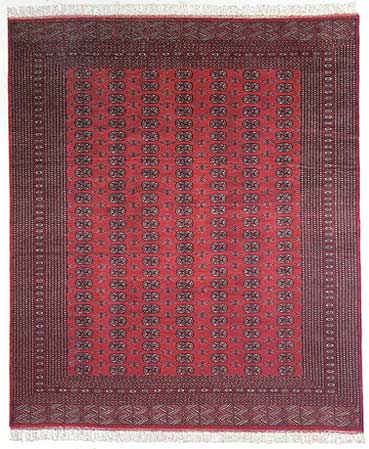 |
PAKISTAN BOKKARA |
In contemporary Pakistan, carpet weaving has remained mainly a cottage industry with the great majority of pieces manufactured in individual dwellings which may contain several looms. Today, rugs are woven with high-quality blends of indigenous and imported wool. Approximately 70% of the weaving is done within a 400-mile radius of Lahore, the capital of the Punjab province. Karachi, the capital of the Sind province, represents some 20% of the total output. The areas around the cities of Quetta and Peshawar generate the remaining 10%.
Until the 1970s, Pakistan had predominantly woven Bokkaras characterized by a repetitive octagonal or gul motif which is based on a traditional Central Asian Turkoman design. Today Bokkaras still account for a significant portion of total production and are available in two styles, Mori and Jaldar. Mori Bokkaras feature the traditional gul motif and come in a broad array of colors including traditional hues (e.g., reds, rusts, and ivories), pastels, and fashion shades (e.g., peaches, corals, greys).
More recent has been the development of Jaldar Bokkaras generally displaying geometric, contemporary-style designs as well as motifs based on nomadic Caucasian sources. Colors are mainly contemporary, including pastels and jewel tones as well as black. Mori Bokkaras are generally woven in qualities of 200 to 242 knots per square inch while Jaldar Bokkaras range from 162 to 200 knots per square inch. Bokkaras come in a full assortment of sizes ranging from one-foot squares to room sizes and runners.
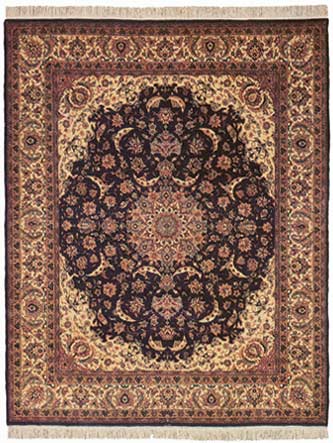 |
PAKISTAN KASHAN |
In the last decade, higher-quality Persian-design carpets featuring colorations attuned to American fashion have become the predominant type of Oriental carpets available in Pakistan. Here, the weavers possess an almost intuitive sense in executing the designs of their Iranian neighbors thanks to their historical association with Persian weaving techniques and to their Islamic cultural and religious background.
By far, the most readily available quality of Pakistani Persian-design carpets today is the so-called 16/18 which is roughly equivalent to 288 knots per square inch. Pakistani 16/18 weavers generally concentrate on reproducing the more intricate Persian patterns namely Kashan, Tabriz, Nain, and Isfahan which require a greater number of knots. These designs are colored to suit all tastes including the traditional Persian reds and navies, in addition to pastels and the very latest designer hues. It's not unusual for these fine carpets to contain as many as 20 different colors. In addition, the 16/18s' low pile height enhances the crispness of the designs and their tight' 'handle" or feel approximates that of their Persian counterparts.
Persian-design carpets are also found in other qualities ranging from about 195 to 324 knots per square inch, but the latter knot count quality only exists in smaller-sized rugs of 4x6 and below.
Pakistan deserves careful consideration as its very strong production capacity is geared to specific American decorative requirements. The broad range in colors and patterns, as well as the availability of higher-end Persian-style carpets, provides ample choices for today's consumer.
RUMANIA
Since the Middle Ages, when Rumanian weavers learned the craft of carpet weaving from their Ottoman rulers, Rumania has regularly produced carpets for export. Production was limited until after World War II when government-sponsored weaving centers, or cooperatives, were established. At that time, significant efforts were launched to reproduce Persian designs, particularly Tabriz-inspired patterns. Since then, Rumanian manufacturers have been most successful in developing new qualities and designs to meet Western decorative tastes.
Weaving in Rumania is performed exclusively by women and is a closely supervised government enterprise. The wool used in their carpets, although coarse, is resilient and lustrous. The predominant quality of carpet produced today is the Bucuresti quality. The weave is approximately 70 knots per square inch and is woven with an all-wool pile on cotton warps and wefts. Four other qualities, Braila, Mures, Olt, and Milcov are also produced with knot counts that range from 70 to about 194 knots per square inch.
Traditionally, most designs have been inspired by Persian patterns. Most popular in the Bucuresti quality are Persian designs such as Herizes, Kashans, and Sarouks executed in traditional colors and in a broad range of fashion colors. Sizes range from small scatters to over-sized and custom-sized rugs, with runners up to 30 feet long. In addition, a more limited selection of non-Persian designs has widened the realm of decorative choices available in Bucuresti and other qualities. Among these are antique-style reproductions of Caucasian and European rugs such as the floral French Savonnerie.
RUMANIA SERAPI | 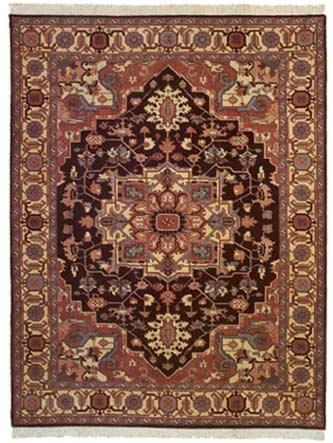 |
Equally important are Rumanian kilims which are part of a rich folk art tradition. Their best historic examples are treasured museum pieces. Rumanian weavers today continue to use traditional flat-weaving techniques to execute the very characteristic curvilinear floral designs. These often incorporate geometric motifs and display a wide range of decorative colorations.
Rumania offers a tremendous production potential mainly due to its talented and well-trained weavers and to its high quality control standards. Thanks to the weavers' adeptness at executing a variety of design types in both pile and kilim rugs, today's buyers have a realm of decorative choices at their fingertips.
TURKEY
Until Persian rugs were exported in the 17th century, Turkish weavings were the only Oriental floor coverings known to Europe and thus the terms "Turkey carpets" and "Oriental carpets" were virtually interchangeable. Turkey's rug-weaving industry dates back to the llth century and was developed successively by the Seljuk (llth - 13th centuries) and Ottoman (c. 1300 -1922) dynasties and by the modem Turkish republic. The Oriental rugs currently being produced in Turkey have the historic character of their antique counterparts in patterns and colors geared to today's decorative tastes.
As in Iran, rug weaving in Turkey is an intrinsic part of its culture and is practiced in villages throughout the country. A substantial portion of the production is destined for domestic and local tourist consumption rather than for export. Thus, much of the demand for these weavings including pile rugs and flat weaves, saddle and grain bags, and silk pieces comes from collectors and consumers looking for something that is both different and distinctive. Indeed, it is often said that Turkey's appeal emanates from its carpets' tribal, primitive character.
Of special interest today is the renaissance of traditional weaving techniques, namely that of using vegetable dyes and handspun wool (produced from both domestic and imported wool) in areas around Izmir, Canakkale, Konya, Kayseri, Oushak, Hercke, Diyarbakir, Malatya, Kars, and Erzurum. Originally initiated in 1982 by the government-administered project DOBAG (Natural Dye Research and Development Project), the resurgence of this weaving art has spread throughout Turkey, making it a major producer of Oriental carpets whose wool is both handspun and vegetable-dyed.
This ancient, time-consuming, and delicate process of using vegetable dyes, as compared to chemical dyes, imparts the wool with a very unique patina. For instance, the darker reds and blues have a very characteristic vibrancy and the light hues exude a complex transparency. Among the plants used to extract dyes are madder and indigo.
TURKEY LALEH | 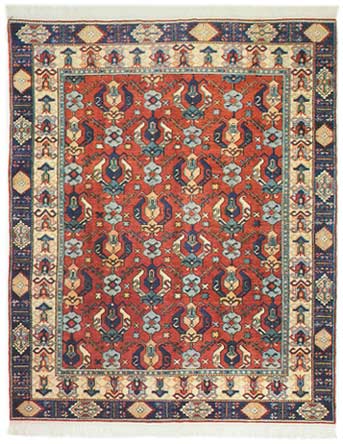 |
Equally important has been the recreation of authentic old Ottoman patterns as well as those from other countries and regions including Iran, Azerbaijan, the Caucasus, East Turkestan, and Transylvania. These adapted patterns, though not originating from the villages or areas where they are woven, are nonetheless integrated into the Turkish weavers' design library thereby bestowing a charm and uniqueness of their own. The designs generally intricate interplays of geometric and curvilinear floral motifs are woven in an array of colors ranging from full-bodied reds, blues, teals, greens, and greys, to the lighter peach and ivory tones. Carving and incising is done to highlight designs in many of the pile rugs.
Among the popular carpet types available today are all-wool Basmakcis that feature geometric patterns inspired by Caucasian and traditional Turkish designs. Burdurs are also popular and are characterized by the angular Persian Heriz design woven in both traditional and contemporary colorations. Hereke rugs, renowned both in their wool and silk varieties, have repeating intertwining floral elements often incorporating the mihrab or prayer niche.
The last decade has witnessed the growing popularity of kilims mainly featuring a broad range of geometric patterns characteristic of Anatolia (a generic term referring to the high plains of Central Turkey). They are also available in the Karabagh variety and bear more Western-looking stylized floral motifs reminiscent of Bessarabians. Although produced throughout Turkey, most of the kilims produced originate from the Oushak and Denizli areas.
The organized production of Oriental carpets in Turkey is one of the most exciting developments in the industry. Indeed, the renaissance in the use of vegetable dyes and handspun wool, and the creative renderings of designs both native and foreign has inspired the production of carpets bearing a unique, handcrafted character, some of which are destined to be the "antiques of tomorrow."
TIBET/NEPAL
Although historical references pointing to the specific origins of Tibetan rugs are unclear, it is believed that carpet weaving in this Himalayan region is part of an age-old tradition practiced primarily for use in the home. Following China's suppression of Tibetan nationalism in 1959, thousands of Tibetans fled Tibet and settled in neighboring countries including Nepal. Shortly thereafter, carpet production began in Tibetan refugee camps, mainly situated in Nepal's Kathmandu (Katmandu) valley. By the mid-1970s, many carpets woven by Tibetans in exile were being exported to Europe. During the 1980s, Tibetan/Nepalese rugs have received increasing attention from the United States decorative market and exports to this country have steadily increased. The primitive, handcrafted look of these carpets, characterized by highly stylized patterns and tastefully orchestrated color schemes, has great appeal for the American consumer.
NEPAL FLORAL |  |
Originally produced as mats, door covers, saddle rugs, bed covers, and pillar rugs (made to fit around Buddhist temple columns), traditional Tibetan weavings generally reflect the significance of Buddhist religion in Tibetan culture and art. Various Chinese design elements were also adopted and transformed by the Tibetans as evidenced by the common use of the phoenix, dragon, and lotus symbols in traditional Tibetan carpets. Today, design schemes featured in Tibetan/Nepalese carpets (that is carpets woven by Tibetan refugees in Nepal) range from Westernized adaptations of traditional Tibetan motifs (e.g., branching floral designs and snow lions) to a vast medley of foreign and contemporary free-form patterns. Among the patterns adapted from non-Tibetan cultures are traditional Persian, Turkish, French, Bessarabian, and American southwest Indian. The contemporary-design rugs feature bold geometrics on open fields and adaptations of Art Deco designs. Whatever their ethnic origins, Tibetan/Nepalese patterns bespeak a compelling simplicity that is enhanced by a color spectrum spanning from the rich reds and blues to the softer lavenders and greys. In some cases, these hues are obtained through the use of vegetable dyes.
Generally, the yarn used in Tibetan/Nepalese carpets is carded and spun by hand. This gives the face of these carpets a wonderful depth and richness achieved through the subtle variation of color and texture. Some rugs are woven exclusively with Tibetan wool which is characteristically flexible, strong, lustrous, and springy. The majority of the rugs woven are a blend of Tibetan and imported wool. Knot counts vary from 30 to 100 knots per square inch with the majority approximating 48 knots per square inch. The looms used today are larger than their native predecessors in order to meet the export demand for room-sized carpets. Tibetan weaving features a unique and ancient knotting technique which utilizes the "axis rod" (warp divider) and "gauge rod" (needle), tools not employed in other rug weaving countries.
Tibetan/Nepalese carpets are increasingly coming into their own in the United States, stirring considerable excitement among American buyers. Indeed, they impart the rustic charm, characteristic of their traditional Tibetan counterparts, while featuring fashion-oriented colors and designs available in a full range of sizes. These bold, eclectic patterns and colorations heightened by a rich texture reveal a primitive sophistication unique to these carpets.
AFGHANISTAN
Although Afghanistan shares its western border with Iran, its carpets have more in common with the tribal weavings of Central Asia in terms of color, design, and weave than with their more sophisticated Persian counterparts. The Afghanis are a nomadic, tribal population constantly traveling from one place to another. Their rugs, woven on small portable looms, are mainly produced for use in their homes, namely to adorn their tents. Therefore, it is not surprising that Afghan weavings are available in limited quantities and generally in small rug sizes. Many feature vegetable-dyed handspun Afghan wool. Various qualities of pile carpets are available, ranging from coarse to medium in weave, in addition to kilims.
AFGHANISTAN BOKKARA | 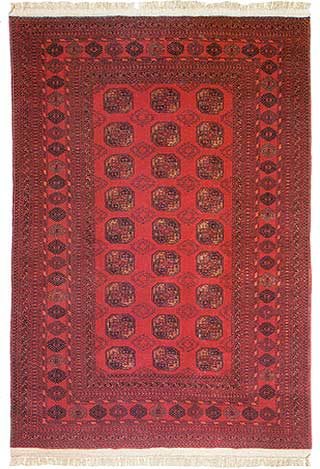 |
Afghanis strictly observe the principles of Islam, which forbid the depiction of human and animal forms. Therefore, Afghan carpets are characterized by easily identifiable geometric patterns. Several types of Afghan rugs exist. Most prevalent is the "Afghan Bokkara," characterized by the gul motif, a large, quartered octagon also called "elephant's foot," generally displayed in columns or rows and framed within a border. Also popular are the nomadic Belouch rugs, generally prayer rugs with geometric motifs. Most Afghan rugs fall into the dark red hues (occasionally blue) with black or blue motifs and sometimes with touches of ivory or green.
Lately, Afghan weavers have produced an interesting selection of "war rugs" exhibiting stylized depictions of military paraphernalia such as tanks, grenades, and guns which are a vivid reflection of the war-torn environment that has reigned throughout the 1980s.
Of all the carpet types available today Afghan rugs are probably the most truly authentic expression of a weaver's culture. They hold a special appeal for buyers seeking truly original ethnic expression in Oriental rugs.
Basic Motifs and Colors
Understanding the meaning of basic motifs and colors can significantly enhance your appreciation of Oriental carpets. Like all artists, Oriental rug weavers were first inspired by familiar forms including animals, flowers, mountains, and architecture as well as by religious symbols and historic and folklore scenes. Islamic weavers used symbolic motifs sparingly, among the most popular being the Tree of Life a design featuring a tree dividing the field of the rug in half denoting water in the desert and eternal life. In contrast, Chinese rugs display a wealth of pictorial symbols including the dragon signifying the emperor, the mystery of life, the power of nature, and the glory of the nation, and the phoenix representing the empress, prosperity, and happiness.Today, attributing meanings to specific colors is more difficult and is probably applicable only to certain antique pieces. Traditionally, green is infrequently found in antique Islamic weavings because its use was taboo, being the sacred color of the Prophet Mohammed. Turquoise allegedly denotes luck; yellow, wealth; blue, truth; and red, sincerity. However, the colors used in today's Oriental rugs are for the most part selected to suit Western decorative tastes and, therefore, do not bear much symbolic significance.

WOVEN THROUGH TIME: DISTINCTIVE SYMBOLIC IMAGERY
OF Oriental RUG MOTIFS
Through the centuries the interpretations of many of these symbols have been lost or forgotten. Still, a basic knowledge of some of these motifs and their meanings will bring to life the mystique of your Oriental carpet.
- Names & Places
- Rug & Knot Types
- From Sheep To Rug
- Rug Loom Types
- Decorating Ideas
- Purchasing Guide
- Basic Rug Care
- Rug History Chart
- Glossary of Terms